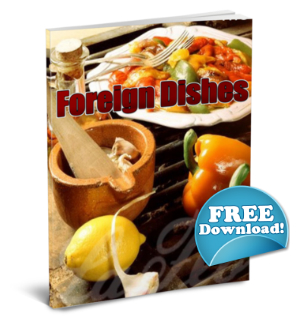How to Buy, Store and Prepare Potatoes
August 8, 2013 by admin
Filed under Kitchen Cooking Guide
No doubt about it…the beloved potato is clearly the most popular vegetable in the United States. Potatoes easily adapt to many flavors and methods of cooking. This article defines the characteristics and the best uses of some well-known potato varieties, how to choose and store potatoes and several basic ways to prepare potatoes without any or a minimum of added ingredients.
Well-Known Varieties, Characteristics and Best Use
Russet Potatoes – This potato is slender, oval shaped with a rough brown skin and lots of eyes. They have a mealy texture when cooked and cooked russets will start to fall apart when cut due to the low moisture and high starch content. This variety of potato easily absorbs butter, dressings and sauces. They are best used for baking, frying and mashing.
White, Red and Yellow Potatoes – These potatoes are round and keep their shape when cooked. Due to their high moisture and low starch content, they have a firmer texture and won’t fall apart when cut after cooking; they are also slow to absorb butter, dressings and sauces. These potatoes are best for boiling, steaming and roasting. They are also excellent creamed or scalloped and in salads. Yellow and red potatoes may be mashed, but they will not be as fluffy as russet potatoes.
New Potatoes – Freshly harvested and marketed during the late winter or early spring, new potatoes are tiny to small potatoes of any variety. Their skin is tender and they do not need to be peeled. When cooked, they have a firm, waxy texture. New potatoes are best when used soon after harvest and prepared by boiling, steaming or roasting.
Tips for Buying Potatoes
> When buying potatoes, choose ones that are firm, have smooth skins and are without any sprouts or blemishes. Avoid potatoes with wrinkled skins, sprouted eyes, cut surfaces, soft or dark spots, decayed areas (usually at the ends), or sunken spots.
> If possible, purchase potatoes that are fairly clean but unwashed. Potatoes that have been washed will spoil quicker.
> Avoid purchasing potatoes with a greenish tint or cast. This indicates that the potatoes have been exposed to light during storage, which can produce a bitter taste and may be toxic to some people.
> Choose potatoes that have a heavy feel and are uniform in size and shape. They will cook in about the same time and will be easier to peel.
How to Store Potatoes
> Store potatoes in a well-ventilated cool, dry, dark area such as a cool closet or dry basement (never under the kitchen sink).
> When stored between 45F to 50F (7C to 10C), potatoes will keep for several weeks. If stored at room temperature or in a warm place, potatoes will remain at top quality for only about 1 week.
> Do not store potatoes in the refrigerator. The starch will begin to change to sugar and alter the taste; the potatoes will also turn dark after cooking.
> It is best not to store potatoes near onions.
Tips for Preparing Potatoes
> To clean potatoes, soak briefly in cool water to loosen the dirt and make scrubbing easier. Scrub gently under running water with a vegetable brush or sponge; trim away any eyes or blemishes.
> Always be certain to remove any sprouts or eyes when peeling potatoes and if a potato appears green under the skin, peel it deeply to remove the green part…that green portion could possibly make you sick.
> To prevent potatoes from turning dark, cook immediately after peeling or cover with water and add a small amount of salt, lemon juice or vinegar.
> When preparing French fries, soak cut potatoes in lightly salted chilled water for approximately 1 hour to remove some of the starch and produce crisper fries.
> Use cooked (not raw) potatoes when making a potato dish ahead to prevent the potatoes from discoloring. Consider cooking the mixture until almost done, cool and refrigerate; complete cooking just before serving.
> Potatoes and dishes with potatoes do not freeze well due to their tendency to become mushy when thawed and reheated. Partially cooked French fries, mashed potato patties and baked stuffed potatoes may be frozen.
Potato Yields
Three medium potatoes equals approximately 1 pound, which will yield:
* 2 cups French fried potatoes
* 2 cups mashed potatoes
* 2-1/2 cups peeled and diced potatoes
* 3 cups peeled and sliced potatoes
* 2 cups potato salad
* 2-1/2 cups shredded potatoes
Basic Methods of Cooking Potatoes
Baked in Oven – Select and scrub potatoes of similar size. Prick each several times with a fork to allow steam to escape while baking and to prevent the skins from bursting. If a soft skin is desired, rub with cooking oil before baking. Place potatoes on a baking sheet allowing room between potatoes for heat circulation or stand them upright in a muffin tin. (If potatoes are wrapped in aluminum foil and baked, they will have more of a steamed texture.) A medium-size (6 oz.) potato will bake in 40 to 45 minutes in a 425F (220C) oven or in about 90 minutes at 350F (175C). When baking several potatoes, keep in mind that a dozen will cook in the same amount of time as a single potato. To reduce cooking time, slice potatoes in half lengthwise, coat cut side with cooking oil and place cut-side-down on a baking sheet. Half of a medium potato will be fork-tender in 25 to 30 minutes when cooked in a 375F (190C) oven. To check for doneness, hold potato with a hot pad and pinch with fingers or pierce with a fork. To serve, use a small knife to cut a cross on top and push on sides and ends gently to fluff.
Baked in Microwave – Choose 4 medium (6 oz. each) slender potatoes of similar size. Scrub clean then pierce each potato with a fork 10 to 12 times. Cover bottom of microwave oven with a double thickness of paper towels. Arrange potatoes in a ‘spoke-fashion’ with the smaller ends toward the center and at least 1 inch apart. Cook on ‘high’ (100% power) in a 700-watt microwave oven for 10 to 12 minutes. Rearrange and turn over after first 5 minutes. Remove from microwave and wrap each individually in aluminum foil. Let stand for 5 to 10 minutes or until uniformly soft when pinched between fingers. When cooking a single potato, microwave on ‘high’ for 2 minutes, turn over, cook for another 2 minutes and check for doneness. Add 2 to 3 minutes cooking time for each additional potato.
Boiled on Stovetop – Scrub, peel and quarter potatoes. Place potatoes in a saucepan and add enough water to cover; add 1/2 teaspoon of salt for each quart of water. Cover and bring to a boil over high heat. Reduce heat and simmer until potatoes are fork-tender (approximately 15 to 20 minutes). Remove from heat and drain. Return to low heat and shake pan until potatoes are dry. Be careful not to overcook potatoes or they may become watery. One or two slices of onion may be added to water while boiling potatoes to add flavor.
Boiled in Microwave – Scrub, peel and quarter 4 medium (6 oz. each) potatoes; place in a shallow microwave-safe baking dish. Add 1/4 cup of water and cover. Cook on ‘high’ (100% power) in a 700-watt microwave oven for 10 minutes. Stir after first 5 minutes to rearrange pieces and to move the ones in the center to the outside edges of the baking dish; continue to cook for remaining 5 minutes. Remove baking dish from the microwave and let stand for 3 minutes (covered) or until potatoes reach desired doneness.
French Fried – Scrub and peel potatoes. Cut into 1/4-inch thick slices with a knife or crinkle cutter, then cut slices into 1/4-inch thick strips. Place potato strips in a bowl of cool water. Add a small amount of salt to the water to prevent discoloration. Soak up to 1 hour to remove some of the starch and maintain crispness. Heat 4 to 6 inches of cooking oil to 375F (190C) in a deep-fryer or heavy saucepan. (Important: Do not overfill fryer or saucepan with oil.) Drain potatoes from water and pat dry with paper towels. Place a handful of potato strips in a wire basket and slowly immerse in the hot oil. Cook until golden brown and tender (approximately 5 minutes). Shake basket occasionally while frying to prevent potato strips from sticking together. Drain on several layers of paper towels. Continue to cook small batches until all strips are fried. Sprinkle lightly with salt to prevent fries from becoming soggy and keep warn in a 300F (150C) oven until served.
Grilled – Scrub potatoes of similar size and coat skin with cooking oil or soft butter. Place each potato in the center of a double layer of heavy-duty aluminum foil (cut into approximately 6×9-inch pieces). Season each lightly with salt and pepper. Bring the longer sides of foil together, then fold the edges several times to seal, allowing space for steam. Fold up short edges of foil and pinch together to seal. Place foil-wrapped potatoes on a grill approximately 4 inches above medium-hot coals. Cook for 45 to 60 minutes or until tender, turning several times. Cooking time may need to be adjusted according to potato size and heat of the coals.
Hash Browned or Home Fried – Prepare steamed or boiled potatoes; drain. Dice or slice into 1/4- to 3/8-inch thick pieces. Place in a large mixing bowl and gently stir in optional ingredients such as chopped onion or diced cooked ham, if desired. Lightly season with salt and pepper; set aside. Generously grease a large skillet (preferably with a ‘non-stick’ finish) with several tablespoons of cooking oil, shortening or strained bacon fat. Place skillet over medium-high heat and add seasoned potatoes; toss gently to coat all pieces. Lightly toss potatoes frequently during cooking (do not flatten with a spatula). Cook until potatoes are golden brown (approximately 10 to 15 minutes). Additional fat may be needed during cooking to prevent sticking. Season cooked potatoes to taste with additional salt and pepper before serving.
Mashed – Prepare peeled and diced potatoes by the boiling or steaming method; drain well. Mash potatoes using a potato masher, electric mixer or ricer until no lumps remain. For each pound of potatoes, gradually add 1/4 to 1/2 cup warm milk and 2 tablespoons of butter or margarine. Add salt and pepper to taste. Beat potatoes with a wooden spoon, whisk or electric mixer until light and fluffy (additional milk may be added to bring potatoes to desired consistency.) Do not over beat or the starch will break down and potatoes will become gummy. If potatoes are not to be served immediately, spoon into an oven-proof casserole or baking dish, dot with additional butter, cover and keep warm in a preheated 250F (120C) oven.
Pan Roasted – Partially boil or steam peeled potatoes, cooking for only 10 minutes until potatoes are barely tender; drain. Arrange potatoes in a baking dish and generously coat with melted butter or margarine. Bake (uncovered) in a 400F (200C) oven for 40 to 45 minutes or until fork-tender. Frequently turn and baste potatoes with additional butter as they cook. Potatoes may be seasoned with salt, pepper, parsley or other herbs before serving.
Riced – Boil or steam peeled potatoes; drain. Force potatoes through a potato ricer or food mill. Add melted butter or margarine to riced potatoes and serve immediately. Riced potatoes may be used to prepare mashed potatoes (see ‘Mashed Potatoes’ technique above).
Steamed – Scrub and peel potatoes. Use a steamer or wire rack on the bottom of a large saucepan. Add enough water to just reach the bottom of the rack and bring to a boil over high heat. Add potatoes, cover tightly and cook until fork-tender. Cooking time will be approximately the same as when boiling potatoes. (Note: New potatoes are particularly good steamed. After gently scrubbing potatoes clean, peel a thin strip from around the center of each potato to prevent the skins from bursting while steaming. Cooking time will be approximately 15 minutes – be careful not to overcook.)
One Potato, Two Potato…
The potato is a relatively inexpensive vegetable, low in calories, a good source of fiber (especially the peel) and a virtual ‘storehouses’ of vitamins and minerals. It is very versatile and adapts well to many methods of cooking.
It is not complicated to learn how to purchase, store and select the proper type of potato for a particular cooking technique. There is a wide variety of ways that potatoes may be prepared and an endless number of main-dish, soup, salad, baked good and side-dish potato recipes. Since there are really no steadfast rules (just guidelines), try experimenting to find out which variety and cooking technique you personally prefer.
Copyright ©2005 Janice Faulk Duplantis








